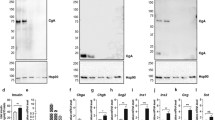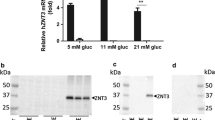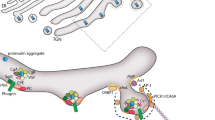Abstract
Previous studies using pancreas from various mammals and freshly isolated islets from rat pancreas have provided evidence supporting possible involvement of the glycosphingolipid sulfatide in insulin processing and secretion. In this study, sulfatide expression and metabolism in the beta cell line RINr1046-38 (RIN-38), commonly used as a model for beta cell functional studies, were investigated and compared with previous findings from freshly isolated islets. RIN-38 cells expressed similar amounts (2.7 ± 1.1 nmol/mg protein, n = 19) of sulfatide as isolated rat islets and also followed the same metabolic pathway, mainly through recycling. Moreover, in agreement with findings in isolated islets, the major species of sulfatide isolated from RIN-38 cells contained C16:0 and C24:0 fatty acids. By applying subcellular isolations and electron microscopy and immunocytochemistry techniques, sulfatide was shown to be located to the secretory granules, the plasma membrane and enriched in detergent insoluble microdomains. In the electron microscopy studies, Sulph I staining was also associated with mitochondria and villi structures. In conclusion, RIN-38 cells might be an appropriate model, as a complement to isolated islets where the amount of material often limits the experiments, to further explore the role of sulfatide in insulin secretion and signal transduction of beta cells. Published in 2003.
Similar content being viewed by others
References
Buschard K, Hoy M, Bokvist K, Olsen HL, Madsbad S, Fredman P, Gromada J, Sulfatide controls insulin secretion by modulation of ATP-sensitive K(+)-channel activity and Ca(2+)-dependent exocytosis in rat pancreatic beta-cells, Diabetes 51, 2514–21 (2002).
Fredman P, Månsson J-E, Rynmark B-M, Josefsen K, Ekblond A, Halldner L, Osterbye T, Horn T, Buschard K, The glycosphingolipid sulfatide in the islets of Langerhans in rat pancreas is processed through recycling; possible involvement in insulin trafficking, Glycobiology 10, 39–50 (2000).
Osterbye T, Jorgensen KH, Fredman P, Tranum-Jensen J, Kaas A, Brange J, Whittingham JL, Buschard K, Sulfatide promotes the folding of proinsulin, preserves insulin crystals, and mediates its monomerization, Glycobiology 11, 473–9 (2001).
Buschard K, Josefsen K, Horn T, Larsen S, Fredman P, Sulphatide antigen in islets of Langerhans and in diabetic glomeruli, and antisulphatide antibodies in type 1 diabetes mellitus, APMIS 101, 963–70 (1993).
Halban PA, Wollheim CB, Intracellular degradation of insulin stores by rat pancreatic islets in vitro. An alternative pathway for homeostasis of pancreatic insulin content, J Biol Chem 255, 6003–6 (1980).
Hoessli DC, Ilangumaran S, Soltermann A, Robinson PJ, Borisch B, Nasir-Ud-Din, Signaling through sphingolipid microdomains of the plasma membrane: The concept of signaling platform, Glycoconj J 17, 191–7 (2000).
Simons K, Ikonen E, Functional rafts in cell membranes, Nature 387, 569–72 (1997).
Hakomori S, Handa K, Iwabuchi K, Yamamura S, Prinetti A, New insights in glycosphingolipid function: “Glycosignaling domain,” a cell surface assembly of glycosphingolipids with signal transducer molecules, involved in cell adhesion coupled with signaling [letter], Glycobiology 8, xi–xix (1998).
Kasahara K, Sanai Y, Functional roles of glycosphingolipids in signal transduction via lipid rafts, Glycoconj J 17, 153–62 (2000).
Masserini M, Ravasi D, Role of sphingolipids in the biogenesis of membrane domains, Biochim Biophys Acta 1532, 149–61 (2001).
Poitout V, Olson LK, Robertson RP, Insulin-secreting cell lines: Classification, characteristics and potential applications, Diabetes Metab 22, 7–14 (1996).
Clark SA, Burnham BL, Chick WL, Modulation of glucoseinduced insulin secretion from a rat clonal beta-cell line, Endocrinology 127, 2779–88 (1990).
Gazdar AF, Chick WL, Oie HK, Sims HL, King DL, Weir GC, Lauris V, Continuous, clonal, insulin-and somatostatin-secreting cell lines established from a transplantable rat islet cell tumor, Proc Natl Acad Sci USA 77, 3519–23 (1980).
Rosengren B, Fredman P, Månsson J-E, Svennerholm L, Lysosulfatide (galactosylsphingosine-3-O-sulfate) from metachromatic leukodystrophy and normal human brain, J Neurochem 52, 1035–41 (1989).
Karlsson G, Månsson J-E, Wikstrand C, Bigner D, Svennerholm L, Characterization of the binding epitope of the monoclonal antibody DMAb-1 to ganglioside GM2, Biochim Biophys Acta 1043, 267–72 (1990).
Svennerholm L, Hakansson G, Månsson J-E, Vanier MT, The assay of sphingolipid hydrolases in white blood cells with labelled natural substrates, Clin Chim Acta 92, 53–64 (1979).
Fredman P, Mattsson L, Andersson K, Davidsson P, Ishizuka I, Jeansson S, Månsson J-E, Svennerholm L, Characterization of the binding epitope of a monoclonal antibody to sulphatide, Biochem J 251, 17–22 (1988).
Svennerholm L, Fredman P, A procedure for the quantitative isolation of brain gangliosides, Biochim Biophys Acta 617, 97–109 (1980).
Davidsson P, Fredman P, Månsson J-E, Svennerholm L, Determination of gangliosides and sulfatide in human cerebrospinal fluid with a microimmunoaffinity technique, Clin Chim Acta 197, 105–15 (1991).
Pernber Z, Molander-Melin M, Berthold CH, Hansson E, Fredman P, Expression of the myelin and oligodendrocyte progenitor marker-sulfatide-in neurons and astrocytes of adult rat brain, J Neurosci Res 69, 86–93 (2002).
Svennerholm L, Vanier MT, The distribution of lipids in the human nervous system. II. Lipid composition of human fetal and infant brain, Brain Res 47, 457–68 (1972).
Skipski VP, Thin-layer chromatography of neutral glycosphingolipids. In Methods in Enzymology, edited by Colowick SP, Kaplan NO (Academic Press, Inc., New York, 1975), pp. 396–425.
Blomqvist M, Kaas A, Månsson J-E, Formby B, Rynmark B-M, Buschard K, Fredman P, Developmental expression of the type I diabetes related antigen sulfatide and sulfated lactosylceramide in mammalian pancreas, J Cell Biochem 89, 301–10 (2003).
Berntson Z, Hansson E, Ronnback L, Fredman P, Intracellular sulfatide expression in a subpopulation of astrocytes in primary cultures, J Neurosci Res 52, 559–68 (1998).
Andersson T, Abrahamsson H, Purification of mitochondria and secretory granules isolated from pancreatic beta cells using Percoll and Sephacryl S-1000 superfine, Anal Biochem 132, 82–8 (1983).
Brown DA, Rose JK, Sorting of GPI-anchored proteins to glycolipid-enriched membrane subdomains during transport to the apical cell surface, Cell 68, 533–44 (1992).
Hsu FF, Bohrer A, Turk J, Electrospray ionization tandem mass spectrometric analysis of sulfatide. Determination of fragmentation patterns and characterization of molecular species expressed in brain and in pancreatic islets, Biochim Biophys Acta 1392, 202–16 (1998).
Merrill AH, Jr., Schmelz EM, Dillehay DL, Spiegel S, Shayman JA, Schroeder JJ, Riley RT, Voss KA, Wang E, Sphingolipids-the enigmatic lipid class: Biochemistry, physiology, and pathophysiology, Toxicol Appl Pharmacol 142, 208–25 (1997).
de Duve C, de Barsy T, Poole B, Trouet A, Tulkens P, Van Hoof F, Commentary. Lysosomotropic agents, Biochem Pharmacol 23, 2495–531 (1974).
Willingham MC, Fluorescence labeling of intracellular antigens of attached or suspended tissue-culture cells. In Immunocytochemical methods and protocols, edited by Javois LC (Humana Press Inc., Totowa, New Jersey, 1999), pp. 121–30.
Olive S, Dubois C, Schachner M, Rougon G, The F3 neuronal glycosylphosphatidylinositol-linked molecule is localized to glycolipid-enriched membrane subdomains and interacts with L1 and fyn kinase in cerebellum, J Neurochem 65, 2307–17 (1995).
Brown DA, London E, Structure of detergent-resistant membrane domains: Does phase separation occur in biological membranes?, Biochem Biophys Res Commun 240, 1–7 (1997).
Harder T, Simons K, Caveolae, DIGs, and the dynamics of sphingolipid-cholesterol microdomains, Curr Opin Cell Biol 9, 534–42 (1997).
Kalka D, von Reitzenstein C, Kopitz J, Cantz M, The plasma membrane ganglioside sialidase cofractionates with markers of lipid rafts, Biochem Biophys Res Commun 283, 989–93 (2001).
London E, Brown DA, Insolubility of lipids in triton X-100: Physical origin and relationship to sphingolipid/cholesterol membrane domains (rafts), Biochim Biophys Acta 1508, 182–95 (2000).
Author information
Authors and Affiliations
Corresponding author
Rights and permissions
About this article
Cite this article
Blomqvist, M., Osterbye, T., Månsson, JE. et al. Sulfatide is associated with insulin granules and located to microdomains of a cultured beta cell line. Glycoconj J 19, 403–413 (2002). https://doi.org/10.1023/B:GLYC.0000004012.14438.e6
Issue Date:
DOI: https://doi.org/10.1023/B:GLYC.0000004012.14438.e6




